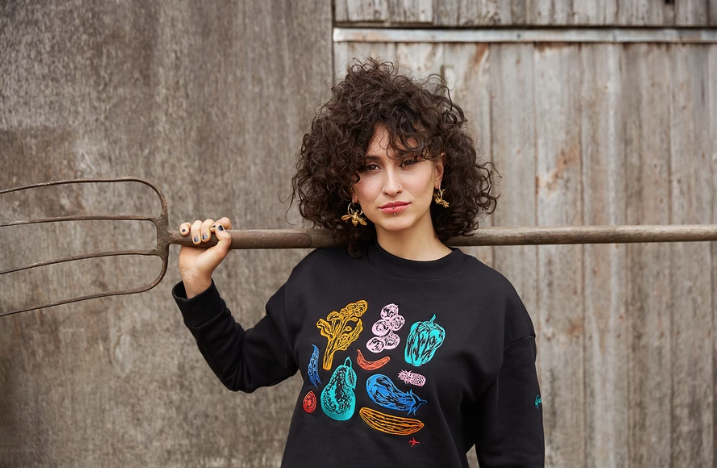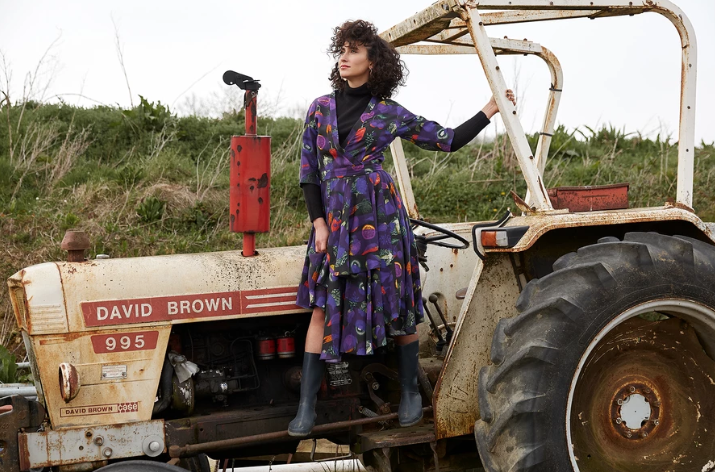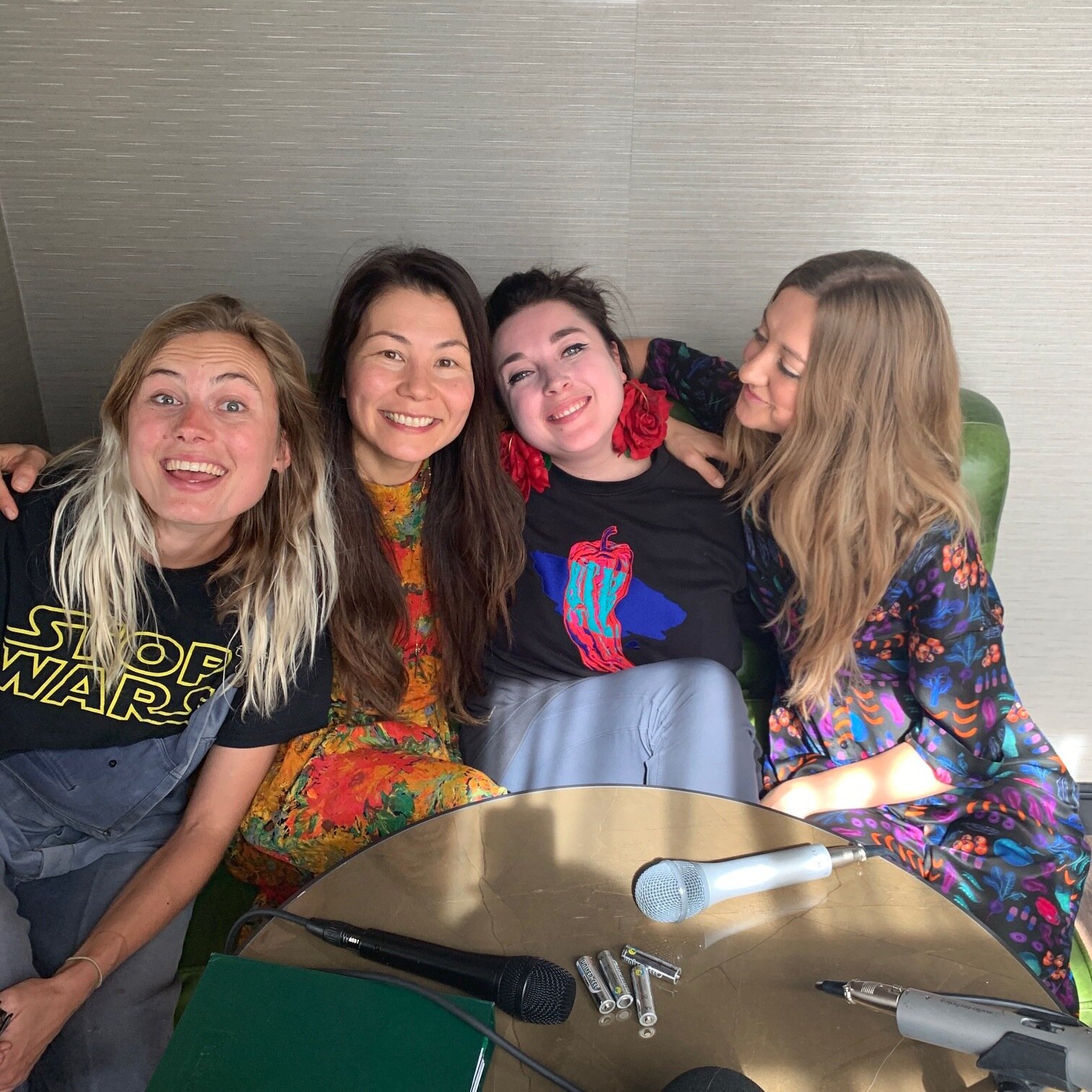Left to right: Abi Aspen Glencross, Sara Kiyo Popowa, Sophie Dunster, Lauren Lovatt
If you've listened to this Episode on Apple Podcasts/iTunes already (don't forget to subscribe - it's free), welcome to the SHOW NOTES.
We have a Patreon page. Love the podcast? To support, Click here .
EPISODE 101 IS ALL ABOUT FASHION & FOOD
Have you ever thought about the water footprint of beef or olive oil? Or how far your food has travelled before it reaches your dinner plate? And what has all this god to do with fashion?
Meet Gung-Ho designer Sophie Dunster, food writer and photographer Sara Kiyo Popowa, and chefs Lauren Lovatt and Abi Aspen Glencross. Whether they’re vegan or just very excited about colourful vegetables; sure that what we eat can affect our mental health or just really keen on yummy food that doesn’t cost the Earth - these four female foodies are combining fashion with activism to put change on the menu. Bon appetit!
Gung Ho Food For Thought
LEARN ABOUT THE ISSUES…
PESTICIDES - “From the start of our lives and often without knowing, we are ingesting a large amount of chemicals. Pesticides are now in most products, and out of all the produce tested by The Expert Committee on Pesticide Residues in Food, the ones that tested with the highest residues were; Beans with pods, Okra, Rice, Poultry meat and most shockingly, infant formula. It is essential that we have the facts on what we are releasing not just into the environment, but our own bodies!” READ THE REST HERE
WATER FOOTPRINT - “Every object or action we take has a carbon footprint, something that we all have a basic understanding of. If we turn on the light, leave the telly on or crank up the heating, however big or small these daily choices we make, we know that they have an environmental impact. But do we really understand our water footprint? The amount of water needed to create the products we use in everyday lives is what makes up our individual water footprint.” READ THE REST HERE
FOODMILES - “We are spoilt for choice. We can have any produce at any time, as well as getting a huge variety of food flown from every part of the world, and we can even have it all delivered straight to our front door. [In the UK] Half of the vegetables we eat are imported, a massive 95% of our fruit comes from abroad…Even though only 1% of our food is transported by air, it still makes up 11% of carbon emissions, and yet it is the most quickly expanding method of transporting food.” READ THE REST HERE
Gung Ho Food For Thought collection, 2019
MEET THE GUESTS…
Sophie Dunster is the artist, activist, and designer behind London fashion label Gung Ho. Instead of seasonal collections, she designs around themes - one per year - in order to start conversations on big issues. Previous collections addressed plastic pollution and the importance of insects in biodiversity.
This year’s Gung Ho theme is Food for Thought. Sophie uses her original prints to tell eco stories through her clothes, and says: “That way, the next time someone compliments you on what you're wearing you'll have more to say than just 'thanks'.”
Sara Kiyo Popowa AKA Shiso Delicious brings her Swedish Japanese roots to the table, with her incredible plant-based Bento boxes. Her latest book is An Opinionated Guide to Vegan London.
Abi Aspen Glencross is a scientist, farmer, cook and botanical explorer who started her career working in the lab but now works on the land. The is co-founder of The Sustainable Food Story, a roving farm-to-fork supper club, that uses food they’ve grown themselves, or from producers they are close to but also zeros in on surplus and underuses goods, foraged ingredients to demystify and discuss food and farming issues through stories.
Lauren Lovatt is the chef and food activist behind Plant Passion and Mindfood. Her projects, classes and pop-ups help chefs, and food lovers in general, connect with sustainable produce and think about ingredients in terms of wellbeing.
LOVE MARA’S WONKY VEG SONG? Find out more about her here. She’s our pick for the next big thing.
Mara
INGREDIENTS LIST…
There are loads of unusual ingredients mentioned in this Episode. I’m sure we’ve missed some. Share your favourites on Instagram - tag us @mrspress hashtag #wardrobecrisispodcast
CBD is the non-psychoactive part of cannabis, and is legal in the UK. It’s still controversial though. Read what the Guardian has to say here.
Lab grown meat is on the rise. Abi worked for Mark Post, created the world's first hamburger without slaughtering an animal. Read more here.
Heritage grains are “perhaps best understood when compared to their alternative, ‘mass market grains.’ Mass market grains, which make up most of the wheat we eat, are developed and grown for their resistance to disease and ability to produce higher yields. A great deal of wheat you see in the supermarket would fall under this category today.
Heritage grains and heritage wheat, on the other hand, are different: there are many ancient varieties of wheat that haven’t been altered or hybridised to be more successful in our agricultural economy.” Via thekitchn.com
British quinoa - yep, it’s grown in Shropshire. Who knew?
Hodmedods is a brand of British beans, read about them here .
How to make fermented oats? Here’s a recipe on To Her Core.
Hissop is a shrub in the mint family native to Southern Europe, the Middle East, and the region surrounding the Caspian Sea. Due to its purported properties as an antiseptic, cough reliever, and expectorant, it has been used in traditional herbal medicine. Hyssop leaves and flowers offer a minty aroma and a slightly piney, bitter flavour.
Shiso is a Japanese herb with lovely big green leaves.
Carob
Carob is a flowering evergreen tree or shrub in the legume family, Fabaceae. It is widely cultivated for its edible pods, and as an ornamental tree in gardens and landscapes. The carob tree is native to the Mediterranean region and the Middle East.
Lion’s Mane mushroom, Hericium erinaceus is an edible and medicinal mushroom belonging to the tooth fungus group. Native to North America, Europe and Asia it can be identified by its long spines, its appearance on hardwoods and its tendency to grow a single clump of dangling spines.
Aztec broccoli
Aztec broccoli, or Huauzontle, is a supercharged purple sprouting Mexican broccoli with a tall central stem from which shoots and leaves crowd around.
Kuri squash
Abi chooses the Kuri squash as the vegetable she’s most like, “because it likes to lie around on the floor and takes a really long time to ripen.” It’s aan orange coloured winter squash, that has the appearance of a small pumpkin without the ridges. It belongs to the Hubbard squash group. Inside the hard outer skin there is a firm flesh that provides a very delicate and mellow chestnut-like flavour.
Abi mentions Real Seeds, a British company selling heirloom and heritage vegetable seeds for home gardeners.
FURTHER LINKS…
The disturbing CNN story on beef that Clare mentions is here.
2040 is the film Clare recommends.
Read about “the madness of filleting Scottish fish in China” here.
THE PEOPLE’S SUPERMARKET is a “Community-minded, ethical grocery store selling healthy, responsibly sourced, seasonal local foods” in London.
Sophie mentions ODDBOX - a veg delivery service, they work closely with farmers across the UK (& from abroad), rescuing fresh, seasonal surplus fruit & veg which are at risk of becoming food waste. Find them here.
Buy Sara’s book Vegan London here.
Pic by Shiso Delicious. Find her on Istagram here
Later,
Clare x











